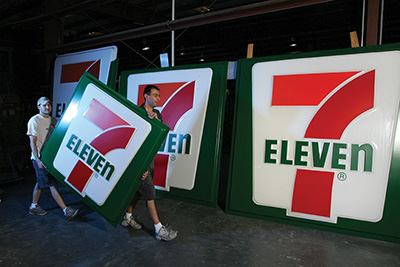LED digital signage plays a key role in pumping up a convenience store’s brand.
By Tim O’Donnell
Retailers are always looking for that bit of cost-savings to give them an advantage over the competition. In the convenience store business, profit margins are slim and the name of the game is to get the customer into the store to make a purchase. Bold monument signage outside the store that is easily readable is a given, but how do convenience stores speak to customers on a more one-to-one basis?
So what’s the answer when you want to lower operating costs and drive traffic? Look to the light — or lights — because LED technology has benefits that will keep paying out over a decade.
For the convenience store industry, the use of LED digital signs at individual gas pumps helps drive that one-on-one marketing traffic. This type of messaging helps get the customer inside the store where there’s money to be made. It peaks the interest of the consumer and provides vital point-of-purchase marketing. Digital LED signs are rapidly becoming an important way to reach the customer. The flexibility of digital signage allows frequent changes to take advantage of changing offers. Special offers can be posted for certain day parts segmenting morning, afternoon and evening with different promotional items.
 Convenience store retailers such as Stripes in Texas and Gate in the Southeastern United States have seen the benefit of LED digital signage to increase their in-store traffic. It is also a key aspect of pumping up a store’s brand. It makes the convenience store appear to be more cutting edge and on top of marketing efforts. Gate began the switch to LED approximately 2 years ago and now all of its locations are LED friendly.
Convenience store retailers such as Stripes in Texas and Gate in the Southeastern United States have seen the benefit of LED digital signage to increase their in-store traffic. It is also a key aspect of pumping up a store’s brand. It makes the convenience store appear to be more cutting edge and on top of marketing efforts. Gate began the switch to LED approximately 2 years ago and now all of its locations are LED friendly.
The use of LED technology helps all types of retailers save money and go greener. Many of the older convenience stores have replaced old light technology with LED to cut down maintenance costs and lower energy bill.
Another national chain convenience store started the LED conversion process about 4 years ago. This operation decided that it needed its 1,750 locations retrofitted in 1 year. Many of the retrofits involved custom work in each location. With the change, the national chain is seeing energy costs reduced by as much as 80% per location.
On average, converting sign lights from fluorescent to LED can reduce maintenance cycle costs from as much as one to three times per year to just once every 5 or 10 years. LEDs don’t burn a filament so their lifespan averages 50,000 hours. A fluorescent bulb lifespan is only 6,000 to 7,500 hours.
Nonprofit retailer Goodwill was looking for the same type of advantage but it also felt the pull of proving that it was concerned about the environment. LED technology provides a “greener” solution for Goodwill in addition to saving the retailer money.
“As a leading nonprofit, we have a responsibility to demonstrate keen social conscience with respect to minimizing any impact our store operations can have in our environment today and in the future,” says Karen Phillips, chief administrative officer of Goodwill.
LEDs require less energy — just 12 volts versus 110 volts for fluorescents. This is due to the fact that LEDs produce more light per watt. This can translate into an operational savings of 60% to 80%. LED bulbs are definitely more “green” in that they do not contain any toxic chemicals such as mercury. Bulbs that contain mercury require special disposal techniques because of the harm to the environment.
Since implementing the LED change, Goodwill has reduced sign-related energy costs by 75% annually.
Even fluorescent double-face pylon and multiple signage types can be converted to LED lighting with a retrofitting. For example, Harbinger Sign, a Jacksonville, FL-based company, has worked with nearly 2,500 7-Eleven ® stores to retro fit their signage. This has resulted in significant savings for the convenience store retailer.
Some other advantages of LED technology include that that they are solid-state devices. There are no moving parts, filaments or fragile glass that can break. This factor alone helps cut down on regular maintenance.
LED technology also allows a retailer to be creative about its sign design because LEDs are flexible and versatile. LEDs are small but they provide a maximum light output. They are compact and lightweight which adds to the designer’s ability to develop something unique.
Besides size, LED color is an important aspect of its value to a sign’s look. LED light is much more vibrant and dramatic. There is no flicker like a fluorescent. The vibrant light provides much more sharper colors including a pure white. This color palate allows a designer more range when developing signage.
Cabana Grill, a brand within the Fiesta Restaurant Group, utilized LED technology in its flagship store in the Atlanta marketplace. A combination of concern for the environment and wish to convey a highly stylized brand, LED was the way to go for its signage.
It’s tough to pass up an opportunity to save money, limit maintenance, go green and be more creative. That’s why so many retailers are focusing on retrofitting their signage to LED technology or opening a new location with LED in place.
— Tim O’Donnell is president of Harbinger Sign. O’Donnell joined Harbinger in 2011 after a long career in the sign industry. He started at Heath and Company, ultimately being named president and CEO in 1991. He was instrumental in helping Heath’s ownership group acquire Federal Sign in 2003, generating combined sales of over $80 million.
